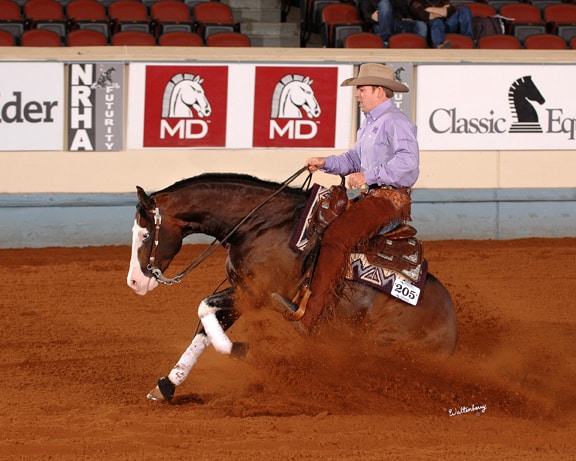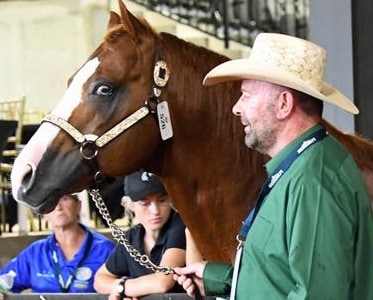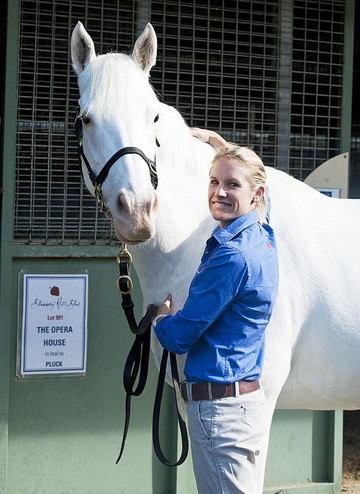Every single horse colour in the world has a base of either RED or Black !!!
Everything else ie (Grey, palomino , buckskin etc) in the result of a genetic factor interacting with that base colour.
Today though, we are going to examine Patterns!
Patterns occur where the base colour is broken up by areas of white.
Whilst white is the common factor in all pinto (or broken coloured) coat patterns, the design or layout of the colour is genetically determined, and is divided into a number of classes.
Remember, that White is not a colour… it is simply a lack of colour in horses.
Tobiano

Tobiano is a dominant gene and as a result is particularly easy to breed for (or avoid).
Being Dominant means that it can become homozygous. (ie two copies of a dominant gene, means that one will ALWAYS be passed on. Even when bred to a solid coloured horse)

The tobiano coat pattern is typically characterized with larger, rounded white spots on the body and white legs. The spots typically have sharper, cleaner edges. The head of the horse is usually coloured with the base coat colour and does not have white caused by the tobiano gene.
However, white caused by other pattern genes can appear on the head. The white spots on the body will generally cross the top-line of the horse.
Frame Overo
Frame Overo is an incomplete dominant gene. Basically this means that it is not always visible.
Frame overo is also linked to a lethal condition called Lethal White Overo which occurs should the gene become homozygous (ie two copies, one from each parent). The resulting foal will be born pretty much all white and will die after birth due to a malformation in the lower digestive system.
This can be avoided by knowing in advance (by DNA testing) and avoiding the breeding of Overo positive horses to each other. Remember that a solid horse could potentially be a carrier of Overo lethal white, so always test.
The white areas in a frame overo tend to be less rounded, and will very rarely cross over the horses spine.(giving the frame affect).

The various splashed white genes.
So far there are 4 separate mutations by this name identified by the numbers 1 to 4. There are thought to be many more waiting to be isolated / discovered.
Some of these splashed white mutations are occasionally associated with deafness, as with many white or white patterned, blue-eyed animals,( including dogs and cats.)
It is important to note that most splashed white horses are not deaf. Hearing loss is due to the death of the necessary hair cells, caused by the absence of melanocytes in the inner ear. Although most splash horses have pigment around the outside of the ear, the pigment must occur in the inner ear to prevent hearing loss.
The majority of them look as though they have literally been dipped in white paint…lower half with a solid colour upper half.
Splashed White 1.

SW 1 Can exist in many breeds. It can be homozygous or heterozygous…
This is also common in Welsh mountain ponies.
Splashed White 2.
SW 2 Is one of the newest mutations and is able to be traced back to a specific mare where the mutation occurred, an American Quarter Horse Association mare called Katie Gun who also happens to be the dam of WEG 2018 Team Ireland reining horse This Guns for Nic 😊 who is also Splashed White 2 carrier but only really displays it himself through his one blue eye… However, he does appear to be throwing it.
Spooks Gotta Gun great example of SW2. The clean division of colour in the tail is a strong association with SW.



Splashed White 3.
SW3 is connected so far specifically to the TD Kid line of AQHA. There is very little to say on Splashed White 3 because it appears to be quite new, and as of yet no homozygous foals have been born…
This could mean one of two things… one being that it is so new that it wouldn’t yet be a feasible cross (ie it would have to be two VERY close relatives bred together).. The other could be that it is homozygous lethal and dies or is non-viable in utero.

White 3 Photo – from Kids College Fund on Facebook
More Splashed White.
Then there are the many splashed white genes that have not yet been identified
A good example of this would be our old TB mare and foal Mata Biru. This is possibly a new mutation, or is certainly not one that has been observed in her bloodline before, and as of such tests negative to any of the known mutations. although Northern Dancer does appear in many excess white pedigrees.


Dominant White Coat Pattern
Dominant white is another coat pattern… Quite a few examples of this occur in the Thoroughbred stud book.
Remember that even though these horses are totally white, they do have a red or black base colour that the white is masking. They are basically a giant white patch that covers the whole body!

They are not to be confused with Grey.. which is simply a factor that causes normal colour to grey out over time.. and something that serious colour breeders avoid since it removes the contrasting coat colours.
It is thought that several different mutations within a specific gene appear to be responsible for the development of dominant white colouring.
One of the best know examples would be The Opera House.

In Conclusion.
Most of the coloured genes can be identified, and specifically bred towards. A simple DNA test is both affordable and sensible when planning coloured breeding as this helps avoid the guess work.
Always bear in mind that a horse can contain more than one pattern and so one is often dealing with a combination of ‘designs”
For Ireland, the easiest place to send hair for DNA testing is http://www.dnaireland.ie/equine-dna-tests/
Full instructions available on the website.
Check out The Genetics of Breeding Colour Part 2 Appaloosa Colouring Here>>
Article was written by Bernard O’Sullivan and is Part 1 of a Two Part Series, and was originally published in Irish Sport Horse Magazine in February 2019.
Bernard O’Sullivan – BHS Instructor and Irish International Reining Athlete. Bernard and His Partner Julian Kingsford breed and Train Reining and Sport Horses in Australia . You can contact Bernard at www.australiancolouredperformancehorses.com.au
